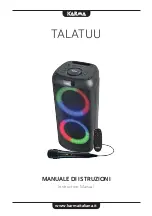
58
U
sing
K
EF
Co
nn
ec
t A
pp
Understanding the EQ Settings
On a desk/distance from the front edge of the table (Expert Mode: Desk
Mode):
This setting adjusts the “presence” region (170 Hz +/- 1 octave). Too
much causes a muddy sound, while a lack of presence makes the sound distant
and empty.
Distance to the wall (Expert Mode: Wall Mode):
This setting adjusts all
frequencies from around 500 Hz downwards, causing broader changes than
Desk Mode. A dip in these frequencies causes a tinny sound, while too much
of these frequencies can overwhelm the overall presentation with lower
frequencies.
How is your room? (Expert Mode: Treble Trim):
This adjusts the frequencies
above 500 Hz. A damped room can make sound seem muted, while a lively
room can make it sound harsh. Move towards damped to reduce the muting
effect, or move towards lively to tame harshness.
How large is your room (Expert Mode: Bass Extension):
This setting adjusts
the bass extension of the speakers. The larger the room selected, the lower the
roll-off point.
Understanding the Subwoofer Settings
Subwoofer/Speaker Balance (Basic Mode):
This controls the bass output
between the subwoofer and the speakers. If the slider is moved more to
“Subwoofer”, most of the bass output will be handled by the subwoofer.
High-Pass Frequency:
Frequencies above the set point will be played by the
speakers.
Sub Out Low-Pass Frequency:
Frequencies below the set point will be handled
by the subwoofer. This can overlap with the high-pass frequency to help
integrate the speaker/subwoofer more effectively with no dip or peak in overall
response.
Sub Gain:
This changes the signal level output to the subwoofer.
Sub Polarity:
Ideally, the speakers and subwoofer should be moving in the
same direction at the same time, otherwise frequencies can be cancelled out.
Switching the polarity of the subwoofer can resolve a perceived lack of bass
response.
















































